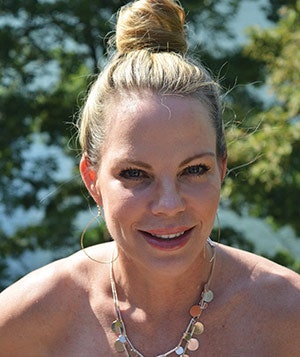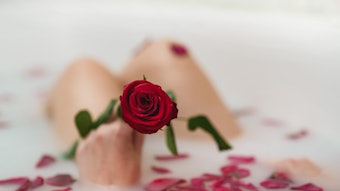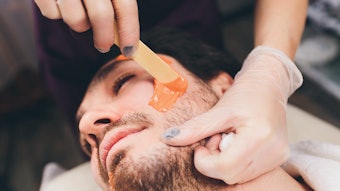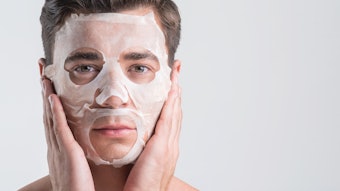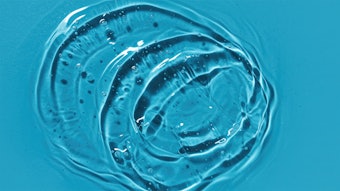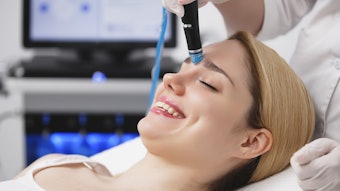
Massages tends to capture the limelight when it comes to the most well-known body treatments at a spa, but they aren’t the only items on the menu that leave the body feeling energized and relaxed. Scrubs can be luxurious in scent and touch, a treat for the senses and the skin and a great way for a guest to extend their spa experience.
“Enhancing your guest’s treatment with a Himalayan salt exfoliation prior to a massage allows the body to go into a deeper state of relaxation, while enhancing blood flow, mineral absorption and aiding in detoxification — not to mention leaving guests with vibrant looking skin,” explained Jessica Smith, spa director at Spa Shiki in Lake Ozark, Missouri.
Understanding Body Scrubs
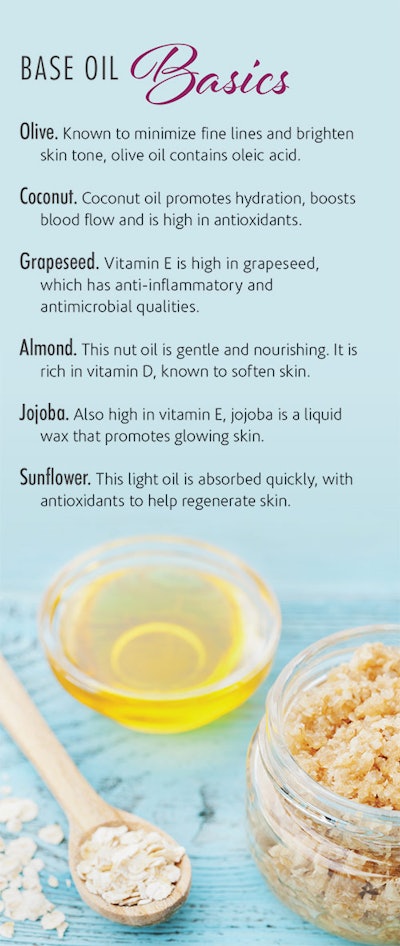
A body scrub is essentially a skin care product used to remove dead skin cells through exfoliation. In the process, it helps increase blood circulation to the surface of the skin, drain lymph nodes and leave the skin feeling cleansed and rejuvenated. With the dead skin cells removed, skin will also be better able to absorb moisturizing body products better.
On a biological level, the outer layer of cells in our skin regularly shed to make way for the healthier new cells underneath. As we age, this process naturally slows down. Clients know this happens to their faces and often take steps to help push the turnover process along. However, they often forget that their bodies should get the same attention and the same push. That’s where a body scrub comes into play. By exfoliating the skin, we help speed the process of removing dead skin cells and bringing healthy new ones to the surface, which can improve skin’s look and texture almost immediately.
In a professional setting, a salt exfoliation and body wrap make for a winning combination. A body scrub made from Himalayan salt, organic oil and essential oils is applied for extensive exfoliation, along with a wrap for increased absorption of products. By wrapping the body after exfoliation, mild sweating of the client occurs, which allows the body to further absorb all the nutrients in the products, especially the nutrients in the Himalayan salt. It’s key that the client stays warm, not overheated, through the process to encourage
that absorption.
In a home setting, this can be achieved by applying the body scrub in a warm bathroom, kept steamy from a hot shower. Depending on skin type, at-home body scrubs may be used from one to three times a week, and their therapeutic value is only amplified with regular use.
Body Scrub Ingredients
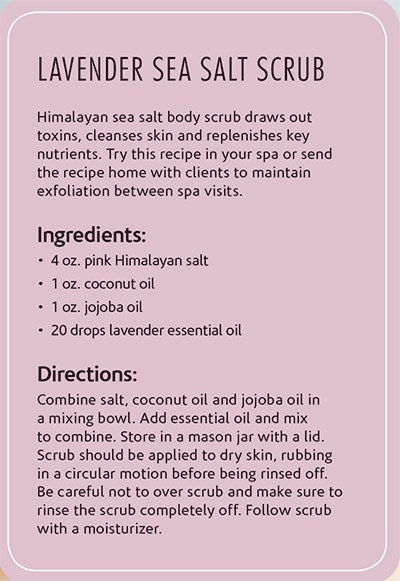
Although the ingredients used for a body scrub don’t have to be as gentle as those in a scrub used on the delicate skin of the face, it’s important to remember that any product we use on our bodies is only as good as the ingredients we put into it.
Most body scrubs include some combination of sea salt or sugar, oils and essential oils, and choosing the right combination and type will determine the results.
Smith points out that her therapists enjoy the uniqueness of the Himalayan salt exfoliation on their spa menu.
“Our therapists enjoy the ability to customize the exfoliation process with essential oils that the guest can choose, as well as the salt texture, from fine to coarse,” noted Smith. “We all enjoy cocktailing and mixing products and giving a personal touch to our guest experience.”
Consider the following when deciding what type of body scrub to incorporate into your spa menu.
Himalayan salt. Pure Himalayan sea salt is a natural exfoliant that brings its own slew of benefits to any product or treatment. In a body scrub, it can unclog and purify pores, promote skin cell turnover, balance oil production and smooth skin tone. In addition, Himalayan salt packs therapeutic mineral benefits, such as acting as a natural air purifier that removes pore-blocking toxins from the air, helping skin breathe easier, tightening the skin and improving skin texture. Containing 84 trace minerals needed for the human body and its systems to function properly, Himalayan salt can also promote circulation, reduce inflammation and act as a detoxifying agent and general muscle relaxant.
Sugar. Although, sugar doesn’t offer as many therapeutic benefits as Himalayan salt when used in body scrubs, it is another good option to use as an exfoliating source, especially if used as a compliment to a sea salt body scrub routine. Sugar is a natural humectant, which means that it draws moisture from the surrounding environment. When used on your skin, it increases the body’s ability to receive moisture and remain hydrated.
Sugar is also a natural source of glycolic acid, which can be particularly helpful for aging skin. Glycolic acids break down the bonds that hold skin cells together, allowing for quicker turnover and leading to younger-looking skin. Keep in mind that, like salt, sugar comes in varying textures. For a facial scrub, the smaller granules found in brown sugar make for a more delicate product. For a body scrub, raw sugar is a good option.
Oils. Whatever base oil you choose, organic should be the first choice when it comes to body scrub ingredients. Even though the oil is not for consumption, its absorption mandates the use of quality oil. Also keep in mind that different oils offer different benefits. A few options of base oils are detailed in the sidebar Base Oil Basics.
Essentials oils. Like base oils, different essential oils offer various benefits, and most basic homemade body scrub recipes will incorporate a few drops of certain combinations to glean particular health benefits. The scent is a factor, too. Essential oils are one of the quickest ways to infuse any body scrub with a spa-like quality by creating a soothing, calming atmosphere that appeals to multiple senses at once. Although the list of essential oils is extensive, consider the addition in Body Scrub Essential Oil Faves.
Top Tips for Body Scrubs
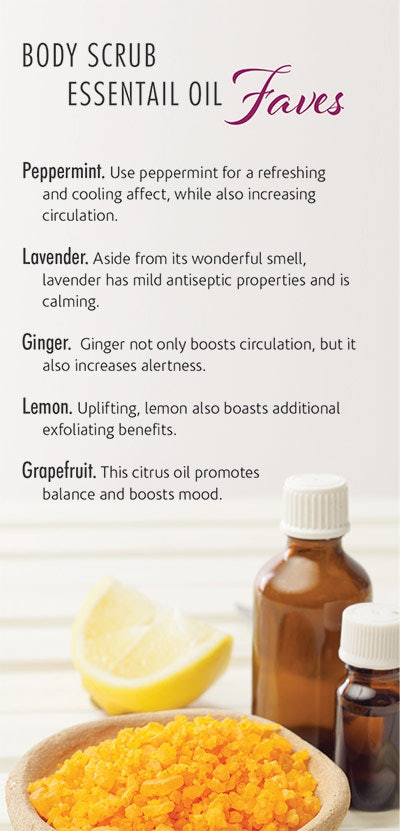
Tip 1. Remember that even though there is a body scrub for everyone, not every body scrub is for everyone. Sensitive or thinner skin can’t withstand the same level of exfoliation as firmer, less sensitive skin. Individuals with sensitive skin should try exfoliating once a week until they’ve built up more of a tolerance to the process, whereas those with less sensitive skin can likely use a body scrub as many as three times a week without any issues.
Tip 2. Test any new body scrub on a small portion of skin before applying it to the whole body, just in case the client reacts negatively to any of the ingredients. If a reaction occurs, adjust the ingredients until you land on the right combination.
Tip 3. Be careful not to use too much pressure when applying the body scrub. Although pressure from the massaging motion does enhance certain benefits (increased circulation, for example), too much pressure will make the product too abrasive, which will wreak havoc on the skin. If you find that your scrub is too abrasive even with gentle pressure, you likely need to swap your exfoliant for a finer-grain option (think brown sugar vs. raw sugar).
Tip 4. Don’t forget the environmental impact of the products you use. Any scrub that you apply to your body will end up being washed down the drain, so it’s important to use ingredients that are as natural as possible. Our lakes and rivers will be grateful for your avoidance of harsh products and chemicals.
Tip 5. A warm environment opens pores and increases the body’s ability to absorb the product. Create a warm steamy environment to apply the body scrub to ensure efficacy for the client. Advise them to do the same with their at-home scrubs.
Take Care of Body Skin
How we treat our skin and what we treat it with makes a noticeable difference in our overall health and well-being. It’s about taking care of our bodies, from the outside in.
